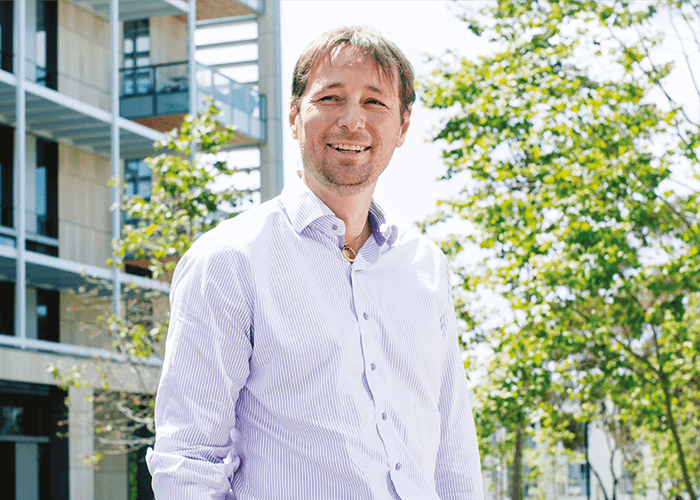I pursue what I think will have an impact – throughout my career I’ve pivoted numerous times, something uncommon in academia. During my third year as an assistant professor, I moved from top-down MS to work on understanding the functional role of small molecules using microbial imaging MS. People tried to discourage me; yet, it was the resulting microbial paper that set me apart and led to my being recommended for tenure. In 2012, I shifted once again, redirecting my focus towards molecular networking and, more recently, repository-wide MS data analysis. And my team and I certainly haven’t finished; if something impactful arises in the future, we won’t hesitate to change direction again.

The MS and natural product communities that discover new molecules have certainly done themselves no favors by creating closed environments for reference libraries, and failing to make data (and knowledge about the data) publicly accessible in uniform computer-readable formats akin to the gene sequencing community. I believe that published data, code or scripts should be publicly available unless a specific disclosure is provided to explain why this is not possible, especially if the work is taxpayer-funded. It is odd to me that analysis is generally still conducted one data set at a time, rather than in the context of cumulative knowledge. Slow, inefficient, and incomplete systems are the result. Our mission to generate data, capture knowledge and make this knowledge accessible is likely why our GNPS infrastructure and the associated tools such as MASST and ReDU are currently getting 200,000 accessions each month. In 2016, we could annotate less than two percent of data in an untargeted MS experiment; today, that number has climbed to five percent and is growing quickly. Imagine if it was closer to 50 percent – how much more capable would MS be? And what type of applications would we have?
One day, MS will be incorporated into smartphones, allowing consumers to conduct analysis in real-time. When will that happen? It will depend on whether the community makes an effort to organize itself; if it does not, I fear that progress will continue at a snail’s pace.
Bill Gerwick has been an informal but influential mentor since I joined the University of California, San Diego. He engaged me by bringing me along on collection trips, and promoted a truly holistic approach to science. His ethos was clear: to develop well-rounded scientists who are truly engaged with the entire scientific process, rather than just focused on the lab bench, and have interests outside their work (in my case rock climbing, hiking and mountain biking). After all, we must be inquisitive about our surroundings if we are to generate new ideas rather than simply regurgitating those of others.
I emulate Bill by promoting creativity in my co-workers (students, post-docs and staff) but also ensuring they are exposed to unique opportunities – once they come to me to report that they’ve had an original idea, tested it and provided answers completely independently, I know they’re ready to take the next steps forward in their career. On a more practical level, I try to ensure my students are fully engaged by involving them in workshops, in-person grant reports, collection trips, and broader group administration – and I encourage them to develop of their own ideas.
There’s a lot of confusion, particularly among younger scientists and post-docs, regarding the importance of maintaining a work–life balance. The suggestion – often propagated on social media – that you need to work 80 hours a week to earn a Nobel Prize is harmful and unhelpful. To be successful, you need to conduct good science, but if you prepare well ahead of time and you are focused and efficient in your work, then the hours worked become less important. It’s what you deliver that counts. Sacrificing your health and hobbies is no way to do that.
Of course, social media can also be a force for good in science: it drives exposure to different opinions, which dispels the risk of “bubble-thinking” within your lab. Through Twitter, I’ve learned a lot about the bottlenecks other scientists are facing in MS, and this has actually instigated many exciting collaborations.
My door is always open – it doesn’t matter how busy I am. Some people take advantage of it – I might see them 10 or 20 times a week – while others pop in once or twice a month. It really depends on the needs and interests of the individual – we are all unique. Every Friday we conduct “efficiency meetings” – we discuss issues with instrumentation and any lab challenges we are facing, which ensures that technical knowledge is disseminated throughout the entire group. In addition, we try to foster a dynamic working environment by holding joint meetings with Rob Knights’ group – this exposes our team to high-level microbial science, while exposing Rob’s group to high-level MS.
We want to be able to extract the maximum amount of chemical information from any data set – not only all the annotations, but also substructure information and relevance of the molecules in biology – in a matter of seconds. To get there, we’ll need standardization of data reporting, inclusion of more MS methodologies such as GC-MS, imaging, and others – all needing new algorithmic learning strategies that include crowd-sourced analysis, machine learning, artificial intelligence, but also simpler network relationship modeling to improve the general connectivity of MS data. The development of tools is driven by real applications. Right now, we’re pushing heavily to understand the role that microbiomes play in human, plant, personal care, food and ocean health – and through that work we are gaining a better appreciation of the limitations of current infrastructure. The ultimate goal? To develop a system that functions as efficiently and as speedily as a Google search.




